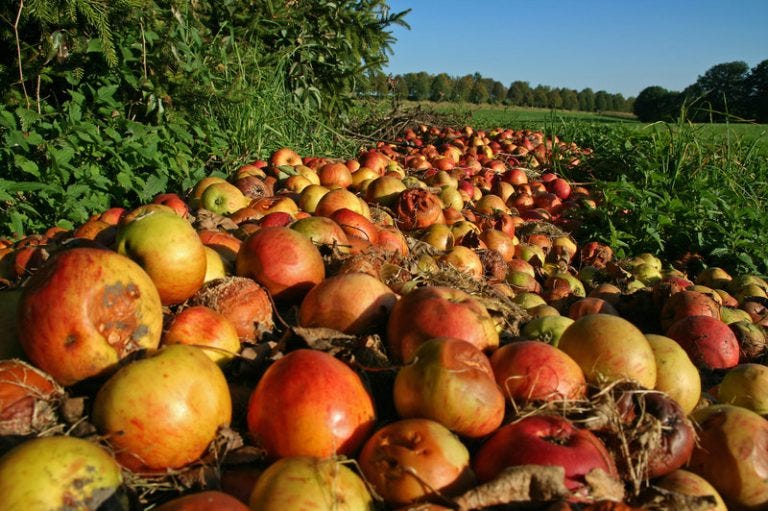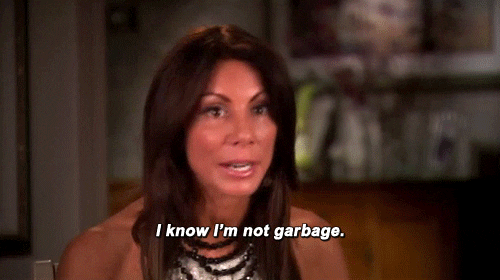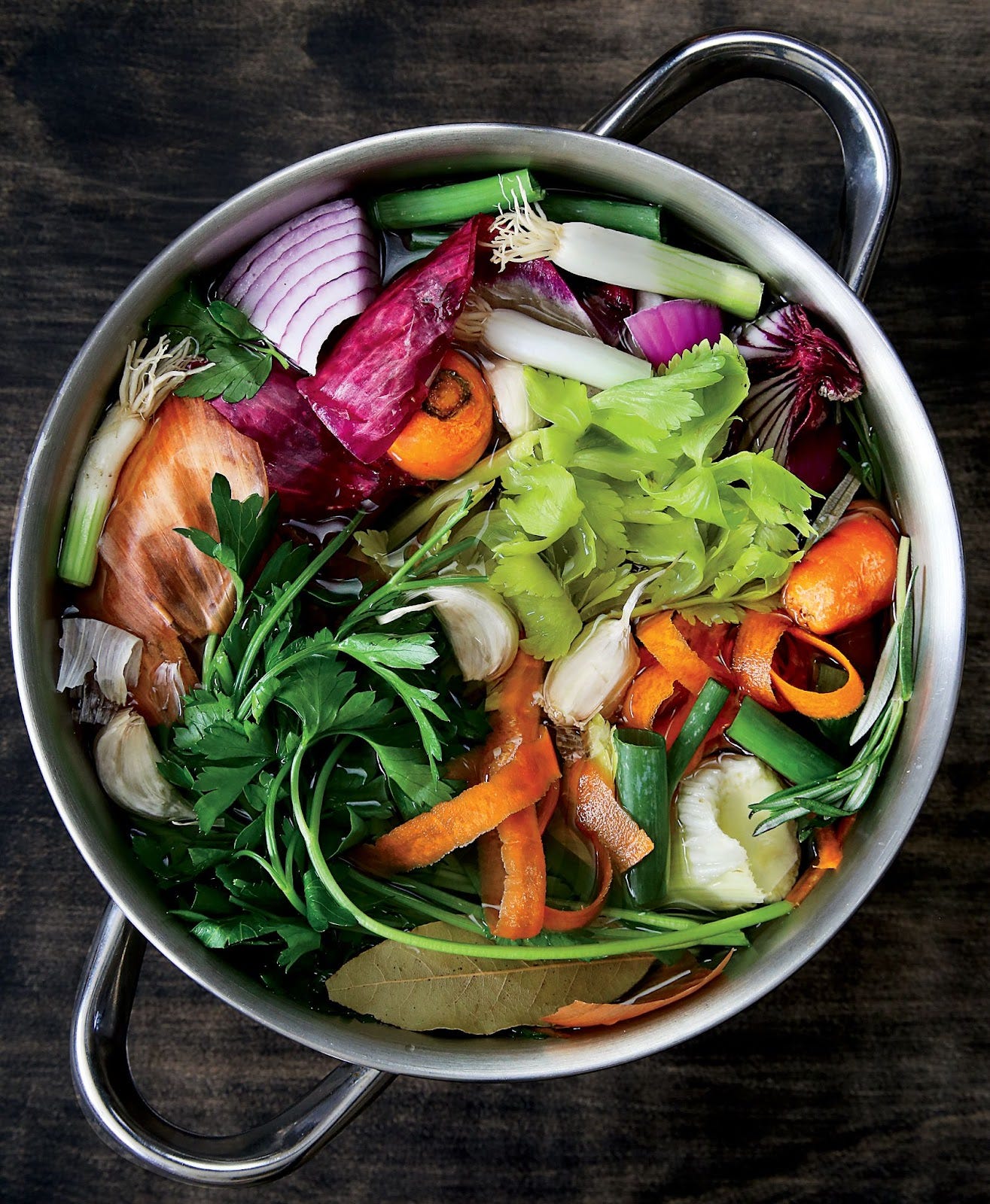How To Eat An Elephant Part 3: Waste Deep
when food produces more problems
Hey Broiler Heads! Welcome to the third installment of our series How To Eat An Elephant where we practice giving a fuck about climate change, one day at a time. We’ve examined single-use plastics, the hidden cost of household paper on forests, and how to start eliminating them both from your life. We got a FUCKTON of helpful recs and tips in the comments that are worth checking out. You guys are smart as hell.
This week it’s all about food waste.
Last month, we explored leftovers as more of an ethical and economical argument for eating all the food we have at home. But unsurprisingly, our food system plays a huge role in climate collapse. Over a third of food in the US goes to waste ending up in landfills, being incinerated, thrown down garbage disposals, or dumped somewhere in our country or a neighboring country. According to the EPA, food waste is the single most common material to end up in our landfills. That amount of food waste is the equivalent of $408 billion dollars, 4 trillion tons of water, and has the climate footprint as the ENTIRE US aviation industry (commercial, passenger, and military) each year. If you’re more of a visual learner, that is like a 40-ton tractor getting filled up with food and heading right to the dump every 20 seconds, every year. That is a staggering amount of food and an immoral waste of resources. We can easily do better.
At the macro level, the world is finally realizing this is a problem, largely because of the huge economic cost behind it. The US has pledged to reduce its food waste by 50% by the year 2030 and considering we’re in the top 5 of global food wasters, that’s no small goal. Governments are turning to native communities with long historical memories on how to be better stewards of the land while using its resources to grow food more efficiently. The next generation of scientists are creating systems for monitoring and reducing food waste long before that produce even reaches consumers. Some states are also rising to the challenge. California’s compost law went into effect this year which requires people and organizations in the state to separate organic material (like food and yard waste) from other garbage.
As organic materials decompose in our landfills, they release carbon dioxide and methane, two greenhouse gases we all know fuck up the environment. Hotter summers, harsher winters, stronger storms, all because we’re not eating the food we produce and purchase. Many landfills try to capture as much of these gasses as possible but municipal solid waste landfills are still the third-largest source of human-related methane emissions in the US. ReFed, a national nonprofit working to end food waste in the US, has a nifty lil’ tool to see how each state handles food waste as a matter of policy. The good news is that we’re not in this alone but large scale action does not absolve us from improving things in our own homes. In addition to the tips I included in our last discussion of food waste, I’ve dug up a few more that are worth making into daily habits.
Compost
I’ve never been a homeowner *cries in millennial* and that leads people to assume that I can’t compost. Sure, I might not have property to hide an outdoor compost bin but modern composting doesn’t need much space. I keep a small container in my kitchen that affixes to one of my cabinets where I conveniently toss food scraps when I cook. When it fills up, I walk it out to the green bin and dump it. It takes barely any work.
At our office, I just use a large bowl and set it up as part of my mis en place. I throw all my food scraps in there while I cook then dump them in the compost bin that was left behind in the yard by a previous tenant. That little bin has taken 5 cookbooks and +500 recipes worth of food scraps. Despite tossing in yard waste and turning it many, many times, it has NEVER had to be emptied and is still only 50% full. It’s like fucking magic.
The habit of separating food waste while you cook is an easy way to start seeing how much organic matter you may be tossing out. I grab my garbage bowl (thank you Rachael Ray) before I even grab my knife. If your city or state doesn’t have a green bin program, plenty of local farmer’s markets and/or community gardens will happily accept certain food scraps and organic material from you. Sure, it might take a little bit of googling or *gasp* asking in person but that is a process you only have to do ONCE. You got this.
Buy Locally Grown Produce
We all have the greatest of intentions when we buy fresh produce: salads all week, grilled artichokes for dinner, bananas with breakfast. But every week, we let a little slip through the cracks and things start to spoil. If this is one of your biggest problems, buying locally grown produce is a great solution. This produce will have a much longer shelf life and taste better than that tomato flown in from Chile because it hasn’t been sitting in cold storage getting further from harvest and closer to spoiling. I buy a shitload of lettuce and the greens purchased at the farmer’s market last me at least TWICE as long as anything I’d buy at the store. Identify the produce that most often goes to waste in your home and find it locally if possible or just buy less. Your budget and the planet will thank you.
Vegetable Scrap Broth
Waaay back in our first book, I included a guide on how to save veggie scraps in your freezer to make an easy broth while reducing kitchen waste. That shit is as relevant and easy as ever. All you need to do is keep a gallon bag (like one of these) in your freezer and throw in scrap bits of produce left over from cooking. Things worth tossing in: the ends of onions, carrot peels, celery, garlic, shallots, green onion pieces, and leek roots. Also, toss in any produce you might’ve overbought and is starting to look not so hot. Mushrooms, bell peppers, fennel, and herbs like parsley, rosemary, and thyme that got dried out or wilted as hell are great too. Just don’t throw in cruciferous veggies like cabbage or cauliflower which make for a gross, bitter broth. Basically, if you think that the water some vegetable was boiled in might taste good, then try that fucker out. Here’s a little recipe guide.
1. When your bag is full, it’s time to get boiling. Ideally you want about 5 cups of scraps. Add the scraps to a large pot with around 9 cups of water. You’re aiming for around a 1:2 ratio of scraps-to-water.
2. Get this going to a good simmer over medium heat. Add 1 teaspoon of salt and some pepper to give it a little more flavor. Add 2 bay leaves if you’ve got them. Let this all simmer together uncovered for around 1 hour to get all those flavors out.
3. Turn off the heat and then let the pot cool down. Strain out all the veggie scraps using a mesh strainer or some cheesecloth and you’re good to go. You can freeze this broth for later, or store it in the fridge for up to a week. Put that gallon bag back in the freezer and wait to fill it up all over again.
Reducing our food waste at home is a great way to combat climate collapse. Systematic change is needed on all levels to make the world a habitable place for future generations, including in our own homes. When you make these small, incremental changes they become habits that you no longer even think about. That’s how we build a future and slow climate collapse, one intentional step at a time.
Thanks so much for joining us here in The Broiler Room. Substack, who publishes this fine newsletter, just launched Notes which is sort of like Twitter when it was still fun. You can share and repost content you and others on the site create. We’re fucking around with it and encourage y’all to check it out too. Plus, its available in-app AND the desktop version of Substack which is fucking awesome.
What tips or tricks do you guys use to reduce food waste in your lives? Let us know in the comments because we have a feeling we can learn a few more for you guys.










Grat article of stuff I have done for years. Moon used to dig a hole in the garden and plop in the scraps. Before winter a bigger hole and keep it going. Keep going w/ good stuff! Also at some point could you please do an index that cross references all your books recipes?
Thank you for this! Very important topic. There's a great app (i think also in the states) called too good to go that allows you to buy older vegetables/produce/meat from stores. still good, just not what the typical consumer wants.
we also have a movement here called "kook je koelkast leeg" which translates to "cook your fridge empty."